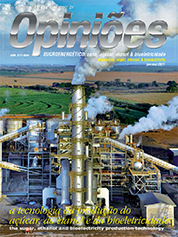Celso Procknor
President of Procknor Engenharia
Op-AA-27
Juice treatment
We can currently divide the industry in two main parts: mouth and stomach. The mouth includes the mill or the diffuser. The stomach includes the equipment that transforms saccharose and reducing sugars extracted from sugarcane into sugar and/or ethanol. The juice treatment system, the first part of the stomach, must deliver the treated juice to the subsequent process phases with minimum energy consumption.
The purpose of the treatment system is to remove undesired elements from the juice, which in short are: microorganisms, insoluble impurities, soluble impurities and water. The efficiency in removing these elements is measured, respectively, by counting the number of colonies, turbidity, color and brix.
Undesired microorganisms are removed by increasing the temperature, which is why heating the juice is the first treatment phase. In the near future, the need to comply with Regulatory Norms of the Ministry of Labor (NR-8, NR-12, NR-33, among others) will result in automatic CIP (Cleaning in Place) systems. In this context, plate heat exchangers will be increasingly used, mainly of the sealed type that can receive heat from several sources, to save energy, including low temperature vegetable vapor under vacuum. We also foresee the use of heat exchangers designed to recover heat lost by flash evaporation from the juice.
Insoluble impurities have been removed either through sedimentation (low brix) or by flotation (high brix), which are expected to continue in the near future using trayless clarifiers and short residence times. The alternatives under study are the ones that use membranes or horizontal centrifuges (decanters).
Membranes that support higher temperatures are expensive, and the ones that work with temperature limits are not recommended due to the risk of contamination. Both consume a lot of electrical power and chemical products in their regeneration, with the impurities being retained in the retentate, whose destination must be worked out case by case.
Horizontal centrifuges are also expensive and consume a lot of electrical power, and need to be tested just as the membranes were. Both alternatives do away with turbidity quite well, but not with color. Turbo-filter type equipment to remove “fine” turbidity after sedimentation is currently the best choice.
The best process to remove soluble impurities is crystallization, which takes place in the boiling house. Some of the color can be removed earlier in the treatment system (sedimentation or flotation) by adding chemical products that transform some of the soluble impurities into insoluble impurities. The cheapest chemical element for this purpose is sulphur, used as SO2.
Although buyers pressure for outlawing sulphur in the process, even the best French wines have sulphite as a conservant in their composition. It is important to keep sulphite content in the end product within the legal limits and to adopt automatic safety systems in the industry to avoid accidental SO2 emissions to the atmosphere.
The alternative product for the future is ozone, which signals significant production and maintenance cost reductions that will need to be proven in practice. Turbidity removed by sedimentation is to be found in the mud that must be filtered. In filtration, the belt press has increasingly been replacing the traditional rotating vacuum filter, a trend that is expected to continue.
A horizontal centrifuge may be tested in this application, although its initial cost and electrical power consumption are higher. The removal of water must take place through evaporation until reaching the necessary brix for producing sugar and ethanol. A challenge for the future is to meet the Ministry of Labor’s Regulatory Norms referred to above.
The preferred equipment will be of the type that allows cleaning using the automatic CIP system, while not jeopardizing workers’ safety. Probably, cleaning efficiency will decrease and will result in the need for a larger heat exchange surface being installed, and the use of easier to clean materials. Another challenge will consist of avoiding the degradation of sugars, with the consequent increase in color in the juice.
The degradation of sugars results from a combination of high brix, temperature and residence times in equipment. The trend toward high vapor bleeding in the first and second evaporation effects will continue, so as to save vapor in the process and thus get maximum surplus electric power. This high vapor bleeding means juice with higher brix and temperature, increasing the degradation risk of sugars.
Thus, it will be advantageous to utilize evaporators with short residence times and small boiling point elevation. Regardless of the design of the actual evaporators, more advanced automation monitoring systems will be essential, for the purpose of precisely controlling brix and temperature.
Evaporation thus becomes a “water factory” and therefore efficient entrainment separators must be included in the process in order to facilitate the use of condensate, while avoiding losses. Vegetal vapor from the last effect will then be condensed in indirect heat exchangers (evaporation condenser), aimed at reducing the impact on the environment.
To remove turbidity from the syrup after evaporation whenever necessary, filter systems have been tested, intended to replace the flotation process, in which some of the color is also removed. We are unaware of whether such systems have been approved in the field. To save vapor in the process, we will increasingly operate with syrup with a brix close to 70%, bearing in mind that the filtration of more dense and more viscous syrup will also be a challenge.




